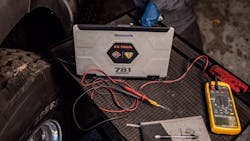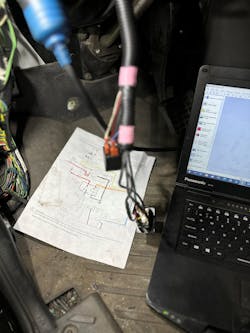With many years of experience in the service and repair of commercial vehicles, Missy Albin has seen firsthand the evolution of diagnostic triage. Today, she’s applying what she’s learned as a senior lead master technician at Taylor & Lloyd, Inc., an International dealership in Bedford, Massachusetts.
“Triage really came into effect with multiplexed systems on trucks and buses,” Albin said. “Over time as well, telematics became a means of effectively diagnosing issues and accelerating service. These solutions let us prioritize repairs, manage shop activity, and most importantly, improve uptime for customers.”
When a vehicle comes in for service at Taylor & Lloyd, Albin related, the goal is to provide a diagnostic report and repair estimate within two hours. To meet that objective, service writers, in addition to having conversations with drivers about what’s going on with the truck, can also utilize International’s OnCommand connection remote diagnostics solution.
“By accessing fault codes before the vehicle arrives, service managers have more information about a unit’s health,” Albin explained. “That facilitates triage by helping create an initial action plan, including determining the right technician for the job. For example, I’m assigned electrical and module issues more often, and we have other lead technicians who primarily handle problems with different vehicle systems.”
See also: Don't distress; de-stress your diagnostic process
Albin noted that a good lead technician will follow established diagnostic procedures as well as use their experience to think inside and outside the box. Troubleshooting is usually handled in steps, she related. For example, based on the fault codes, the process can start with checking simple items like fuses or sensors. Plugging in diagnostic tools would be the next step. Some of the steps she often takes include the following:
- Consider the big picture, organize systems, and use a process of elimination to identify the root cause of fault codes across multiple systems.
- Review active and inactive codes to separate concerns.
- Prioritize active fault codes and realize that inactive codes might not meet a threshold in the moment, especially if there is an intermittent problem.
- Separate code descriptions by systems, then group them to make it less overwhelming to look at each group of codes individually, but keep in mind that different groups may be related through symptoms and not codes.
The result, along with repair histories and driver concerns, leads to a diagnostic path, Albin noted.
“At that point, we usually know if the repair can be made quickly or if the truck will require extended diagnostics with different tests and procedures,” she explained. “Once the cause of a problem is determined, we can see what parts are needed and how long the repair will take, and most importantly, we can advise the customer.”
Albin also offered ideas about the tools that are required for effective diagnostics. A laptop with OEM and OE software and solutions such as Cummins INSITE and Bendix ACom PRO, among others, are essential, she said.
The right diagnostic software is important for an efficient repair plan, Albin stated. Aside from that, the tool list is not long but should include diagrams, a multimeter for electrical testing, a load tester, and pressure gauges.
“Diagnosing commercial vehicle issues can be challenging, but finding and following a good repair path will avoid headaches and help technicians solve even the most complex problems,” Albin said. “Having a playbook for diagnostics and triage is what returns vehicles to service faster.”
Maximizing triage efficiency
For triage and diagnostics to be done quickly and efficiently, technicians need to rely on a few basic tools.
“A battery tester and a diagnostic code reader are essential for any heavy-duty shop,” said Jennifer Grabowski, product manager, Bosch Automotive Service Solutions. “Before starting a diagnostic scan of the vehicle, a battery tester should be used to test the state of health and state of charge percentage of the battery. It’s important to make sure the battery is properly charged before using a diagnostic tool, as a low battery can generate erroneous trouble codes during a diagnostic scan.”
An effective triage process combines a thorough vehicle scan with a diagnostic solution for all makes and models, Jason Hedman, product manager at Noregon, said. “Using a single application for triage, diagnosis, and troubleshooting makes the entire repair process more streamlined and efficient,” he explained.
“Rather than using countless component-based applications, a single application for all steps of maintenance simplifies training and gives technicians a holistic view, leading to a more effective triage process,” Hedman added.
It is essential to have software that can examine the entire vehicle, noted Diesel Laptops CEO Tyler Robertson. “The majority of commercial trucks on the road today have various manufacturers of brake systems, engines, transmissions, collision warning systems, and cab/chassis controllers,” he said. “You need to make sure you have the proper software that allows you to connect to the vehicle one time and read all the data on all the components.”
“A heavy-duty code reader for Classes 4-8 vehicles that can read trouble codes is a must-have for any shop,” Grabowski agreed. “It’s a portable, handheld device that can diagnose ABS, transmission, and engine issues quickly, and it can help troubleshoot the complexity of the issue and help technicians determine if it is easily fixed or may require a fuller diagnostic scan.”
A heavy-duty code reader is not a replacement for a full-function bidirectional heavy-duty diagnostic system, Grabowski added, but it can quickly pull codes as well as read, record, and play back live data streams for further analysis and diagnosis.
See also: Maintenance leaders talk rise of diagnostic tools in the shop
With diagnostic software tools, a roll call of all vehicle ECUs can be taken at startup, according to T.J. Thomas, director of marketing and customer solutions, Controls Group, at Bendix. “Diagnostic software can generate very comprehensive reports that show important component information, active and inactive DTCs, and other event information,” he explained.
“The reports can be run before and after troubleshooting has been completed to enable a clear understanding of some of the critical information on the vehicle before and after it entered the shop,” Thomas added. “This can be very helpful when reviewing vehicle records for trends at a later time.”
Fixing vehicles correctly
When a truck rolls into the shop with an issue, maintenance technicians know their goal is to fix that vehicle correctly and get it back to work in a timely and cost-effective manner. How to go about that isn’t always so clear, even with the power of modern diagnostic tools and streamlined triage processes.
Incorrectly determining the cause of a problem has costly and time-consuming consequences. That not only puts the truck in the triage bay again, preventing the fleet, the driver, and the shop from making money, but also jeopardizes the reputation of the shop.
The key is in knowing all of the information that is needed. Effective triage and diagnostic processes, the use of the right tools, and the assignment of the job to the right technician can effectively define and address a truck’s issues or help determine if it needs to be escalated to a more extensive repair.
An efficient repair practice identifies and determines issues quickly, improves shop productivity and efficiency, and minimizes customer downtime.
About the Author

Seth Skydel
Seth Skydel, a veteran industry editor, has more than 36 years of experience in fleet management, trucking, and transportation and logistics publications. Today, in editorial and marketing roles, he writes about fleet, service, and transportation management, vehicle and information technology, and industry trends and issues.

